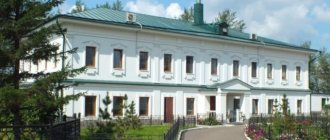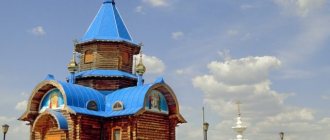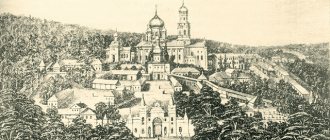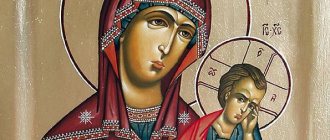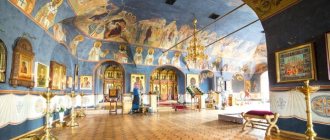The Church of the Life-Giving Trinity on Gryazekh is an Orthodox church located in the Moscow historical district of the White City, in the Central Administrative District of the capital. It has the status of a cultural heritage site. The modern temple was built in 1861, according to the design of the architect Mikhail Dorimedontovich Bykovsky, in the neo-Renaissance and historicism styles. The construction was financed by the famous Moscow industrialist Evgraf Vladimirovich Molchanov, state councilor and merchant of the 1st guild.
Church of the Life-Giving Trinity on Gryazekh - Yandex panorama. Cards
The building of the Church of the Life-Giving Trinity on Gryazekh looks majestic, but it lacks some of the classical attributes of a religious building. Its bell towers and domes were demolished during Soviet rule. On the side of Pokrovka Street, the temple is decorated with a large pilaster portico. The porch of the building is made in an unusual style, visually reminiscent of a triumphal arch. The building is decorated with a massive stucco frieze using floral patterns.
Schedule
Services in the Church of the Life-Giving Trinity on Gryazekh are held on holidays, as well as on Saturdays and Sundays. On Mondays, prayer services are held in honor of St. David of Gareji. On Wednesdays there are prayer services at the “Three Joys” icon of the Mother of God, and on Thursdays there is an akathist in honor of St. Nicholas the Wonderworker.
Liturgies are held daily starting at 8:00. On Sunday - at 8:30. On weekdays, services begin at 18:00, on Saturday and Sunday at 17:00.
Schedule of services of the Church of the Life-Giving Trinity on Gryazekh
Lavra of St. David
Garezhdi can amaze any tourist - on the territory of the grandiose complex, almost 5,000 cells of different sizes were carved into the rock by the hands of monks!
The most revered and, of course, the most beautiful place is the Lavra of David. The oldest monastery consists of many cells, which are carved right into the mountainside. Surprisingly, somehow, the monks managed to form a huge cross from peculiar buildings - this can only be seen from a great height.
Lavra is an amazing place. It fascinates with its unusual architecture and atmosphere, which permeates every stone here.
Here you will see the living quarters of the monks, which are decorated in an ascetic style, intricate turrets rising upward, and small caves. Later, numerous terraces and bridges were built that connect different buildings.
Remember that part of this complex is an active monastery, so entry into it is prohibited. But you can go down to the lower courtyard. It is here that another Shrine is located - the Transfiguration Church. You are allowed to visit it; it is very beautiful here, the vaults are painted, there are many icons.
Near the altar (to the right) is the tomb of the founder St. David. A tomb on a modest pedestal is hidden under a small arch. There are almost always many pilgrims here who ask the Saint for healing and well-being. By the way, this is where the stone from Jerusalem was kept. Scientists have put forward a hypothesis that his disciple Dodo is also buried next to David, however, this information has not been confirmed.
Coming out of the Lavra, you will see 2 chapels on a high hill, they are quite small. It's difficult to climb up to them, but it's worth it. From here you have an excellent view of the desert and neighboring Azerbaijan. Numerous “yellow” hills, reminiscent of a vast ocean with waves that separate the plains, an azure sky and an endless horizon - you can admire for hours.
The Lavra acquired its modern appearance only in the 9th century, when it was completed by Hilarion Kartveli, who also built new churches on the territory of the temple complex.
Not far from the temple is the only source of water in this area. It is called “Tears of David” - here the first hermits could quench their thirst.
And if you look closely, you will see specially carved “paths” in the stone on the caves and slopes - this is how the monks collected moisture and provided themselves with water supplies.
Temple shrines
The main shrine of the church is the icon of the Mother of God of the Three Joys. Every Wednesday, the icon is taken out from the altar for veneration and a prayer service is held. People from all over the city and surrounding area come to this service to pray and ask for help from the miraculous icon of the Mother of God.
Another shrine of the temple is the icon of St. David of Gareja with a particle of his relics. Every Monday she holds prayer services, to which people come to ask for healing from illnesses, to ask for the gift of a child and a successful birth. David of Gareji is a great Eastern Christian monk who helped women heal their illnesses and gave the miracle of childbirth.
© AKfounder
An ancient icon in very poor condition was donated to the temple, on which only the outlines of images of two saints were preserved. It was decided to depict Saints Peter and Fevronia, revered in this church. These Russian Orthodox saints help spouses who pray to them and need solutions to family problems. In 2004, particles of the relics of Saints Peter and Fevronia were delivered from the city of Murom, which were attached to their icon.
The temple also has an icon of the Archbishop of Simferopol and Crimea, St. Luke, with three capsules mounted on it. They contain a piece of his coffin, soil from the grave and a piece of his relics. In this temple, believers can venerate the icon of the holy righteous John of Kormyansky with a particle of his relics. An antimension with a particle of the relics of the holy martyr Archbishop John (Pommer) of Riga and Latvia, bishop of the Russian Orthodox Church, is also kept here.
David Gareji Monastery - a piece of Jerusalem
Already in his declining years, Saint David made a pilgrimage to Jerusalem. But he did not dare to enter the Holy Land, but found three stones near the walls of the city. He decided to take them to Gareji and illuminate the local lands. True, when the templars found out about this, they decided to take the stones from him. Messengers were sent who stopped David and took away 2 stones, but he managed to hide one safely, and it was taken to Gareji.
The saint believed that this piece of the Holy Land completely transformed the local lands, giving them the grace of God.
And today, pilgrims believe that visiting the David-Gareji Monastery is equivalent to a pilgrimage to Jerusalem. True, the legendary stone is no longer kept in Gareji - the artifact was transferred to Tbilisi. There is a belief - when you come here, be sure to find a small stone and take it as a souvenir, then troubles will never befall you, and the most serious illnesses will recede.
Today the complex unites about 12 temple ensembles, some are perfectly preserved, others are practically destroyed by time.
Story
The first wooden buildings on this site appeared in the 16th century. The first church, the predecessor of the current temple, was built at the same time. The church was documented in 1547 and consecrated in honor of the holy Archbishop Basil the Great.
The temple received the name “on Gryazekh” because of its location near the Rachka River, which is prone to large floods. Often a large puddle formed in the churchyard and there was impassable mud. The stream itself came from Poganyye, which is now called Chistye Prudy. In 1759, the crustacean was imprisoned in a pipe, the problem of dirt was solved, but the name of the temple remained with it for centuries.
Not far from the church, the famous Pokrovsky Gate was erected at the end of the 16th century. In 1619, a chapel was built with an altar and a throne for worship in the name of the Intercession of the Most Holy Theotokos. Another 6 years later, the second chapel of the Holy Trinity was erected. It is not known exactly when the first stone temple was built. There is only documentary evidence that in 1701 a new church was being built here.
Church of the Life-Giving Trinity on Gryazekh in 2008., © NVO
Unstable soil led to the destruction of the bell tower and two refectories in 1741. In 1745, it was decided to build a new temple, but without the Vasilievsky chapel. According to some known data, the author of that building was Ivan Fedorovich Michurin, a famous architect, author of the “Plan of the Imperial Capital City of Moscow.” Over the next few years, the chapels of the Holy Trinity and the Presentation of the Blessed Virgin Mary were consecrated.
The destruction of the Patriotic War of 1812 did not affect the Church of the Life-Giving Trinity on Gryazekh. There is no documentary evidence left of the loss of church property. But as a result of the complete restructuring of Moscow after the fire and military destruction, construction of a new church building began in 1819. It was consecrated and opened to parishioners in 1826. The current temple was built and consecrated in 1861. During its construction, fragments of the walls of the old building were used. In the western part there used to be a multi-tiered high bell tower, which has not survived to this day.
The building underwent major renovation in 1899. The walls of the church were re-painted, the marble iconostasis and all the gilding were completely restored, and the necessary utensils were purchased. In 1930, the church was closed by the Bolsheviks and began to be used as a granary.
Since the mid-1950s, the church began to be used as a cultural center. For these purposes, a large-scale redevelopment of the internal walls of the temple is being carried out. A third floor is being built to the northern aisle of the church. The concert hall was located in the central chapel, and a stage was erected in place of the altar. The shaky ground of this place made itself felt again when, in 1979, the ceiling of the building became covered with cracks. Major repairs were carried out until 1981. After that, until the 1990s, the building housed the leisure center of the Moscow regional trade union committee.
© SergeyStepykin
In 1992, the church was returned to the fold of the Orthodox Church. The Trinity chapel of the church was consecrated on June 14, 1992, and the first Liturgy was held at the same time. Services were held only in this part of the church; the assembly hall from the central chapel was finished being dismantled in 2001. The central chapel was consecrated in January 2002. The floors were in disrepair, so another renovation of the building was needed. During the renovation work, a modern heating system was built. On the day of the Entry of the Lord into Jerusalem, which is celebrated on April 4, in 2004 the first service was held in the renovated Church of the Life-Giving Trinity on Gryazekh.
Church warden
In 1812, when Moscow burned, the church was not damaged, but by the middle of the 19th century, the Church of the Life-Giving Trinity on Gryazekh was unable to accommodate all the parishioners. Therefore, the head of the church, philanthropist and merchant of the first guild, Evgraf Vladimirovich Molchanov, decided to rebuild it at his own expense.
Evgraf Molchanov was a major entrepreneur, owner of several textile and calico-printing factories in Moscow and the Moscow region. All his life, Evgraf Vladimirovich helped the poor, orphans, and his workers.
And so, to implement his plan and build the temple, he turns to the famous architect and his friend M. D. Bykovsky.
Where is?
Getting to the David Gareji Monastery is quite easy. It is located 90 km from Tbilisi (only 60 km in a straight line), if you go through Sagarejo. If you go by public transport, then from Sagarejo you will need to get to Udabno, and from here it is only 13 km to the monastery, but through the local desert. Some people go along the road on foot (if such an idea has occurred to them, then it is better to stock up on water and provisions; walking will be difficult due to climatic conditions), while others travel by transport, fortunately there will definitely be no problems with a taxi.
Dodo-Rka Caves
These amazing structures began to appear during the life of David's disciple Saint Dodo in the 6th century. Later a monastery was founded, next to which numerous monks carved small cells. As a result, a separate temple complex was formed here. It is approximately 3 km away from the Lavra and can be reached on foot. The excursion is very interesting - picturesque frescoes, bizarre rock niches, numerous arches at the entrance to the cells. Also in the rock “rooms” ancient inscriptions on the walls and ceilings, which are also found in other monasteries, have been preserved. They are made in different languages - Georgian, Greek, Armenian, Arabic. Surprisingly, some of the inscriptions are applied very skillfully - it is not known how they managed to achieve such graceful forms of each letter. There is information that the monks founded a blacksmith’s workshop on the territory of the Dodo-Rka monastery, where they made tools for creating inscriptions and complex architectural structures.
In addition to the above monasteries, there are a lot of temple complexes and cave cells in Gareja, and if you have time, try to visit Tetri-senakebi, Pir-Ukugmri, Bertubani, Veran-Gareja. They stretch for many kilometers along the border with Azerbaijan.
What else to see in Kakheti: City of Love - Sighnaghi Alaverdi Monastery Complex Lagodekhi National Park
When should I arrive?
Between May and June, the monastery complex will open to visitors in all its glory. Blooming nature, warmth, fresh air and the same historical legendary building, which you can look at for hours, since it fits extremely succinctly into this mountainous area. At other times of the year it’s also not bad here, but rainy weather or mountain coolness can dampen the tourist’s ardor.
This is a great place to think about life, existence, and many other issues. It is quite possible that a trip here will be a real discovery for someone who has not previously even thought about how you can relax with benefit and interest not only on the sea coast or a ski resort.
Natlismtsebeli Monastery
This temple building is not at all like the Lavra of David. It is 10 km away from it, there is no public transport here, you can drive 7-8 kilometers by car and then hit the road on foot. Peace, tranquility and amazing silence, which is not disturbed by the sounds of civilization - Natlismtsebeli is a functioning monastery, founded (the first cave) by David's disciple Lucian.
When you arrive here, be sure to ask which caves you can go into. The main building where you can admire the frescoes and ancient icons is the cave temple of John the Baptist. There is simply an amazing atmosphere here - it’s hard to believe that all these vaults were simply carved out of the rock! Inside there is a small altar, its bottom with skillfully carved stone ornaments. In the middle is a large cross with the faces of Saints. There are numerous frescoes and images of monks on the walls.
After leaving the temple, you can walk to the stone tower, which is located at the foot of a large rock - a narrow path leads here, running off to the right. You can enter the tower through a small niche in the rock, there is no lighting here, bats have settled there.
Natlismtsebeli is a string of caves, both residential and abandoned. Not everyone is allowed to enter here; you need to ask permission from the abbot of the monastery. Walking around the area, you will see the monks who permanently live and work here.
If, after leaving the temple, you turn left, you will see a path that leads to artificial reservoirs (small pools) and the cave of monk Serapion. This monastery is very revered; it is believed that you can ask the Saint for health.
How to get there: about 5 km before the Lavra there is a sign on the highway; near it we turn right and drive about 3-4 km. Here you will have to leave the car (near the gate) and move on foot.
Amazing fauna
It is generally accepted that there are many different species of snakes in the Gareji Desert. There is information that there was once a serpentarium here, and after it was closed, the snakes simply crawled away and took a liking to these places. Whether this is true is difficult to say. But the story with snakes is more like a horror story for tourists. But there really are a lot of lizards here and they are so different and colorful! There are also very large reptiles here, including hoopoes. By the way, numerous turtles live in Gareji; they mostly hide under stones, but in the early morning they can be seen. How do you like the prospect of “getting acquainted” with leisurely monitor lizards? It's possible here!
As for nature, it is unusual and very picturesque here. The mountains are covered with deciduous trees, numerous poppy fields bloom in spring, desert areas surprise with their bizarre shapes - hills, mountains, rocks, huge boulders.
Tetri-Udabno Monastery
If you go around the Lavra, you will see a small store, and right behind it the path to numerous caves begins. A whole complex of cells and residential buildings is the once active Udabno monastery. The complex is spread out like a line of caves. They seem to be hanging on three vast mountain terraces, which practically “roll down” the slope.
The monastery was built during the heyday of Gareji - 11-12 centuries. The most interesting are the unique frescoes that can be seen in each cave. Unfortunately, many of them were destroyed by people; the icons have no faces. Surprisingly, the colors still retain their freshness and richness. Not many people know, but Garezhdi had its own school of painting. Numerous monks honed their skills by painting Udabno - their first works are presented here. The frescoes contain many biblical scenes, faces of saints, and motifs from the lives of hermit monks.
If you plan to come to the David-Gareji Monastery for only 2-3 hours, be sure to walk around at least a “small” circle of the Shrine. During this time you will visit the Lavra and Udabno, calmly examine all the architectural monuments. But to see all the beauty of the complex, you need to set aside several days.
